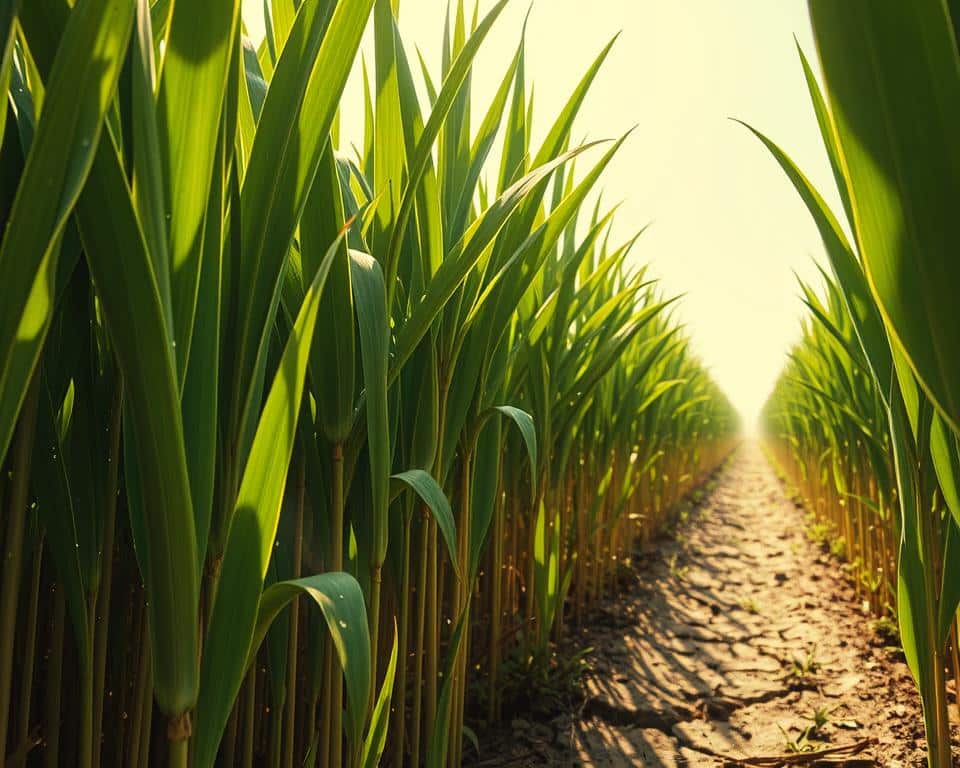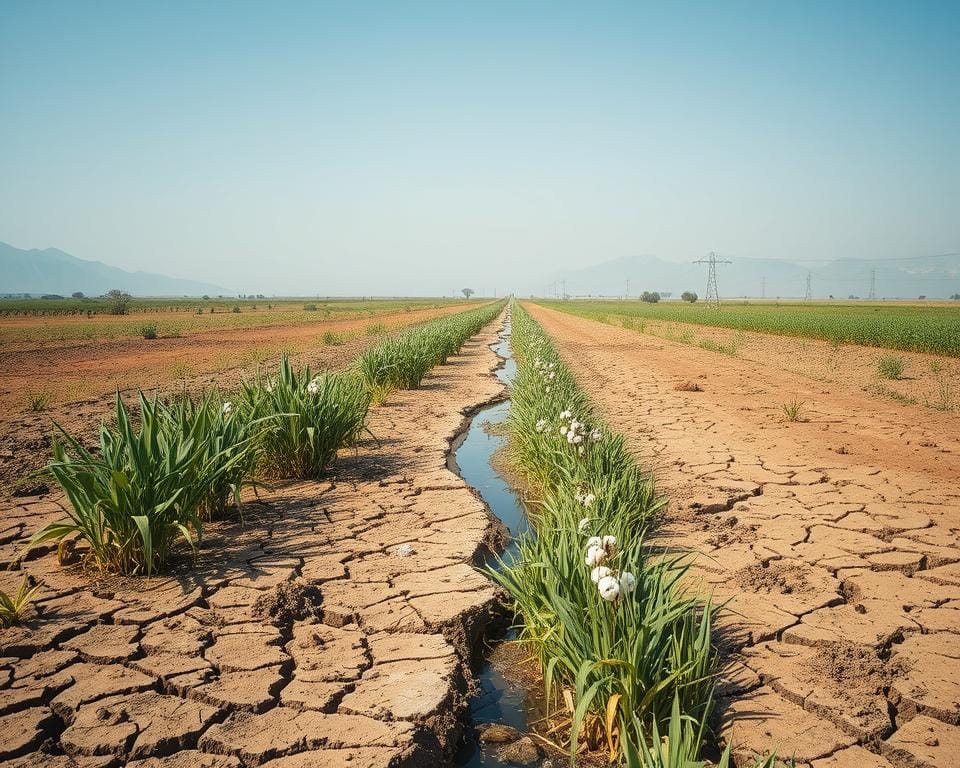Some crops need a lot of water to grow. Knowing which ones are crucial, especially where water is scarce. This high water use impacts water availability and can worsen water crises. It’s essential to use water thoughtfully and farm sustainably.
Crops like almonds need a lot more water than others. For instance, 80% of the world’s almonds are grown in California, which lacks water. Other water-hungry crops include rice, alfalfa, and cotton. They use a lot of water, raising sustainability concerns. The effects on the environment and the challenges posed by climate change urge us to think about what we consume and how we produce it.
Introduction to Water-Intensive Crops
Agriculture uses about 70% of the world’s freshwater, highlighting the need to understand water-intensive crops. These are crops that need a lot of water from planting to harvest.
Water-intensive crops challenge water management, especially in dry regions and areas with low groundwater. Irrigated agriculture is more productive than rainfed but risks depleting groundwater. This groundwater needs rain to refill.
What we eat affects the demand for these thirsty crops. With the world’s population growing, agricultural output needs a 70% boost by 2050. This is to feed everyone, even as 4 billion people face water shortage yearly.
To lessen water use, many farmers are turning to new methods. They’re using drip irrigation, capturing rainwater, testing soil, and mulching to save water. Choosing water-saving crops and using precise irrigation are also key steps.
For deeper insights on water-heavy crops and ways to grow them sustainably, check out these detailed insights. Knowing more about these crops can guide us towards eco-friendly farming choices.
| Key Insights | Statistics |
|---|---|
| Percentage of freshwater withdrawals for agriculture | 70% |
| Daily water needs to produce food for one person | 3,000 liters |
| Expected expansion of agricultural production by 2050 | 70% |
| Efficiency gain from irrigated vs. rainfed systems | Up to 2x |
| Global agricultural reliance on unsustainable groundwater | Over 40% |
Almonds: The Water Guzzlers
Almonds are known as big water users, especially in California. California is perfect for growing almonds, despite water use concerns.
Impact on California’s Water Supply
California grows 80% of the world’s almonds. This uses a lot of water. Just one almond needs about 1 gallon of water.
More than 23 million acre-feet of water are used yearly in Central Valley for irrigation. Around 62% of this water goes to crops. Almonds need as much water as pistachios, walnuts, and peaches in California. Over 80% of almond farms use microirrigation. This helps save water. For more details on water use by crops, check here.
Economic Viability vs Water Usage
Almonds bring in a lot of money and jobs to California, but they use a lot of water. Fruits, nuts, and vegetables create about 85% of the industry’s jobs and income. The goal is to keep farming profitable but also sustainable.
Switching to less water-demanding crops could save a lot of water. Reducing irrigation in some fields by just 5% can cut water use by more than 9%. Using mulch, less tilling, and efficient irrigation can also help save water.
About 930,000 acres of almond farms could help refill water underground. So, almond growers are moving towards saving water. Farmers and policy-makers need to keep finding better ways to use water. With better farming practices, almonds can become more water-efficient. To learn about stopping harmful water practices, visit here.
Rice: Thirsty Yet Essential
Around 3.5 billion people around the world eat rice as a main part of their diet. Growing rice needs a lot of water, making it known for being water-thirsty. Let’s explore how rice farming uses water and where it best grows.
Water Usage in Rice Cultivation
Rice farming uses nearly 30% of the planet’s fresh water. To grow just one kilogram of rice, you need about 4,000 to 5,000 liters of water. Flooding fields is a common, but very water-heavy, way to do this.
However, newer methods like alternate wetting and drying are saving up to 30% of water. But, these new ways also mean there’s 20% more nitrous oxide being released into the atmosphere.
Geographic Areas of Production
Most of the world’s rice comes from water-rich places in Southeast Asia. Countries like Thailand, Vietnam, and Indonesia are big players in rice farming. They often use irrigation to help grow their crops.
In places with less water, like parts of India and Africa, farmers are trying new methods to save water. In 2017, the USDA even gave out $22.6 million to help with these efforts. They want to cut down on methane and make rice farming more sustainable.
Rice is vital for feeding the world, which points to the need for better water management in farming. By improving how we grow rice, we can protect our water and keep this essential food source going strong.
Alfalfa: The Surprising Culprit
Alfalfa might not seem like a big water user, but it is. Its need for water is raising concerns among environmentalists and farmers. It’s key for making feed for animals like cows, which makes its water use even more complex.

The amount of water alfalfa needs has hidden costs in our food chain. Small farms are trying to use water better with new irrigation methods. But big corporate farms might make things worse without meaning to. I think being open about where our food comes from is key. This is easier for smaller farms where you can talk directly to the bosses.
Looking into alternative fodder crops might be the answer. Grains and legumes need less water and are still good for animal feed. Putting money and effort into these alternatives could ease the strain on our water supply caused by alfalfa.
| Crop | Water Usage per Acre (in Gallons) | Economic Yield per Acre (in $) |
|---|---|---|
| Alfalfa | 1,600,000 | 400 |
| Grains | 450,000 | 500 |
| Legumes | 344,000 | 460 |
This table shows big differences in water use between crops. Such data help us choose better, water-wise crops that still make economic sense. I’m all for supporting smaller businesses that farm sustainably. Switching the feed industry to these crops could save water and keep livestock production up. We need to think about these hidden water costs and move towards sustainable farming quickly.
Cotton: The Fabric of Our Lives and Water Usage
Cotton is a big part of the textile industry, making up about 30% of the global market. The World Trade Organization shows this. But, its impact on the economy comes with a high price. This includes its heavy water use, causing concerns for both farmers and those who care about the environment.
Every year, cotton uses about 200,000 tons of pesticides. This is 16% of the world’s total. It also uses 8 million tons of fertilizers, or 4% globally. Growing cotton sustainably is a big challenge because of this. It uses 2.5% of the earth’s farmable land. The water needed to make just one t-shirt is around 713 gallons. This shows why we are worried about how much water cotton uses.
To use less water in growing textile crops, we need better farming methods. Using technologies like data analytics, GPS, and remote sensing can help. These help farmers use water better and cut down on waste. New irrigation systems, like drip or pivot, are also helping save water.
GM cotton types are being made to resist pests and handle drought better. These are steps towards creating more environmentally friendly fabrics. It’s key to keep doing research on how to farm cotton in ways that are good for our planet.
More and more, shoppers want clothes made in a sustainable way. This is pushing the fashion industry to be more eco-friendly. By choosing greener practices, we are contributing to a broader effort towards sustainability.
| Attribute | Value |
|---|---|
| Global Textile Market Share | 30% |
| Annual Economic Contribution (U.S.) | $21 billion |
| Fertilizer Use (Global) | 8 million tons (4%) |
| Pesticide Use (Global) | 200,000 tons (16%) |
| Arable Land Usage | 2.5% |
| Water for One T-Shirt Production | 713 gallons |
Sugarcane: Sweet but Thirsty
Sugarcane is sweet and loved by many but it needs a lot of water to grow. It mainly relies on groundwater, which is scarce in some places. Understanding its water needs and environmental effects is important.
Aquifer Dependence
Sugarcane farming heavily relies on underground water sources. This can lead to water shortages in countries like Brazil, India, and Australia. It’s crucial to find better ways to use water to grow sugarcane, like using more efficient farming methods.

Environmental Impact
The impact of growing sugarcane is significant. Each year, its farms release around 400 million tons of CO2. This is as much as all of France emits. Plus, the land used for sugarcane is vast, more extensive than the UK.
Also, sugarcane farming can harm local ecosystems. For example, in Australia, introducing cane toads to fight pests backfired. Now, there are over 1 billion of them, harming the environment. This shows we need to think about eco-friendly farming.
To reduce harm, farmers should use water wisely and look for other crops too. Techniques like drip irrigation and collecting rainwater can help. By doing this, we satisfy our love for sweets and take care of the planet.
Conclusion
Balancing our agricultural yield with water sustainability is now more important than ever. We have learned that certain crops like almonds and rice use a lot of water. These, along with alfalfa, cotton, and sugarcane, are big users of our water resources. Agriculture uses about 70% of the world’s fresh water, making it key in managing water. However, only 13% of plans to tackle water scarcity focus on farming. This is a big issue that we need to fix quickly.
The future of farming and water depends on smarter farming methods. Innovations like precision agriculture help use water more efficiently, reducing waste and increasing crop yields. Genetic engineering is creating crops that can grow with less water. Also, new technologies for collecting water from the air are starting to appear. These could help get water even in very dry places.
Using less aggressive farming methods can also help save water and improve crops. Teaching farmers about water-saving techniques promotes change and helps conserve water. It’s important for governments and other leaders to work together. They need to make rules that limit how much groundwater we can use and protect water sources.
In the High Plains Aquifer region, not having enough water directly affects how much corn we can grow. For example, during droughts, how deep the groundwater is can matter a lot for corn fields. Areas with deeper groundwater did better than those without, showing why good water management rules are crucial. By investing in smart farming and pushing for better policies, we can take care of our food supply and water for the future. If you want to learn more about managing water, here’s a great resource.

